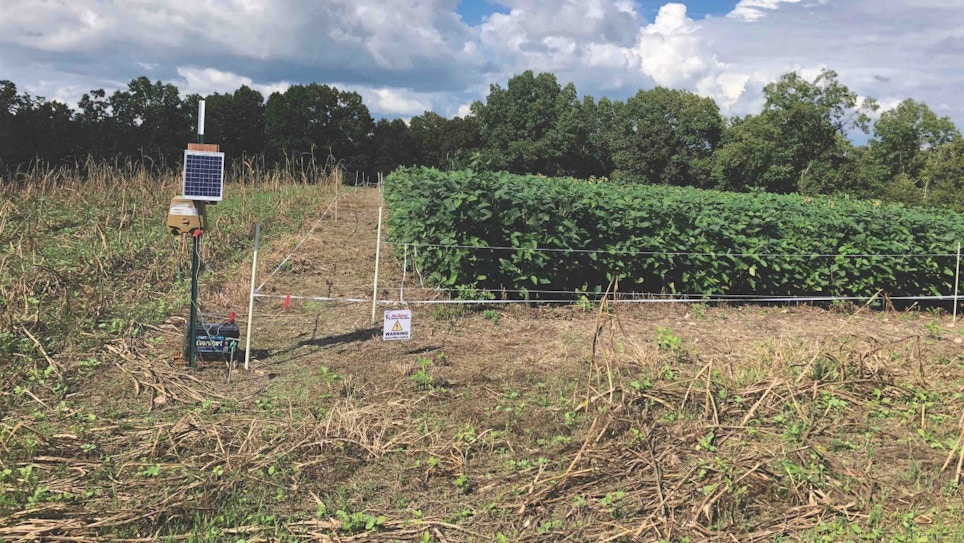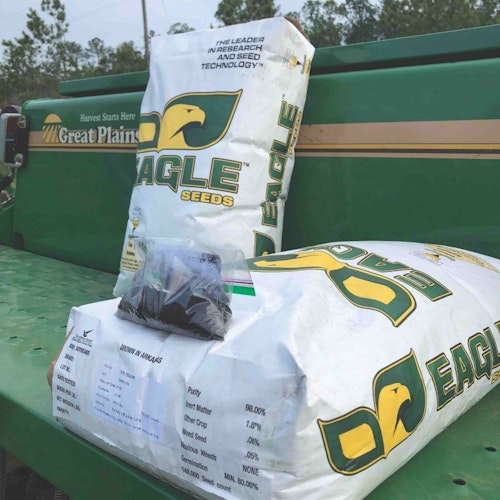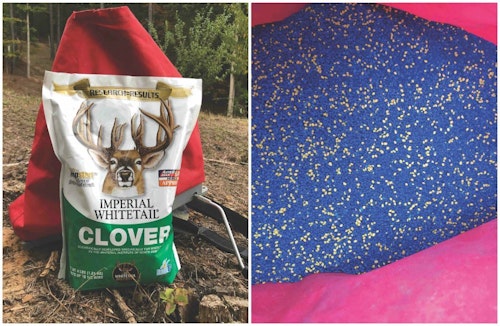
Soybeans are so preferred by whitetails that fields smaller than 5 acres often need to be fenced in order to mature.
Remember the story of the poor boy, Jack, and his magic bean stalk? Legend has it, Jack traded the family’s sole source of income for magic seeds. In a rage, his mother tossed the seeds into the yard where they sprouted overnight and grew a bean stalk into the clouds. The next morning Jack climbed to the top of the bean stalk, where a giant lived in a castle among the clouds. Jack entered the castle and stole valuable treasures, until the giant chased him down the stalk and Jack cut it down, killing the evil giant. In this fairytale, Jack was willing to risk everything to gain riches. Unlike Jack, you can choose seeds for your food plot that offers plenty of reward without the risk.
Did you know that bean seeds are from the legume family? In fact, beans, peas, clovers and many other varieties of plants are members of the legume family. Legumes have the power to not only improve soil fertility, but also provide quality nutrition to deer that feed on them. Sound like a fairytale to you?
Let’s take a closer look to see what the magic is all about.
What Are Legumes?
A legume belongs to the plant family Fabaceae. These plants include well-known forage and agricultural crops such as: clover, alfalfa, peanuts, soybeans, peas, beans and many more. Many legumes are protein-rich forage crops that grow during the warm months when antler, bone and fawn development are all happening. However, the real magic of legumes, are in their ability to fix nitrogen into the soil wherever they are rooted. Nitrogen is the most needed element for food plots and legumes can give it to you free. Let’s first look at the forage value of several popular food-plot legumes for deer.

Nutritional Value
Legumes are a protein-rich forage, which makes it an ideal food plot crop. Whitetail deer require varying amounts of protein at different times of the year. During the fall and winter, protein consumption is lowest when deer are seeking out high-energy, carbohydrate foods to help keep them warm. These include oats, cereal rye, brassicas, acorns, etc. In the early spring and summer months, a deer’s nutritional needs switch from high-energy to high-protein foods for body and antler development. Bucks need about 8 to 10 percent protein daily for optimal antler development and bone and muscle growth. Lactating does on the other hand, require more than 16-percent protein every day. While antlers get all the love, does producing nutrient-rich milk for fast-growing fawns are the ones really in need of a high-protein diet! The good news is, many legumes far exceed the daily protein requirements of both does and bucks and these plants typically grow during the warm months when deer need this nutrition the most.
To get an idea of the protein value of legumes, let’s look at some popular food-plot legumes and the amount of protein they provide when grown in fertile soil. Red and white clovers produce 20 to 30-percent crude protein during the early spring through early summer timeframe. The lush green leaves of soybeans contain 25 to 30 percent crude protein. Alfalfa contains between 16 and 20-percent protein, while iron-clay cowpeas have 25 to 30 percent protein. It’s easy to see why legumes are so popular when looking at how much protein they provide deer.
Legumes such as these soybeans, will pull atmospheric nitrogen out of the air and store it in root nodules below the soil. This not only feeds nitrogen to your existing crop but will be in the ground when you plant your fall crop later in the summer. However, you must inoculate your seeds with a special bacterium for nitrogen fixation to be beneficial. You simply spread the fine powder inoculant over the seeds and mix together before planting.
Soil Building Capabilities
A legume’s real magic actually happens below ground. Nitrogen is the first number of the three-number series found on every bag of fertilizer (example: 13-13-13). Nitrogen is essential for productive plant growth, but it is also the most quickly used and leeched nutrient of the three, requiring it to be added to the soil annually. However, legumes have an amazing ability to pull nitrogen from the atmosphere and deposit it in nodules that form on its roots. These nodules remain in the soil as free nitrogen fertilizer for the current crop and the next crop planted, especially when planting with a no-till drill as the roots remain mostly undisturbed and left in the soil.
Legumes won’t add much nitrogen on their own, though. You have to help them along with a seed inoculant at planting. An inoculant is a fine powder that contains billions of living bacteria. Rhizobia bacteria and legumes form a symbiotic relationship where the rhizobia-infected roots convert nitrogen gas from the atmosphere into ammonium nitrogen — a usable form of nitrogen for plants — in the roots. You simply pour the proper amount of inoculant on the seed and mix it together a bit before planting. However, each legume needs a specific strain of inoculant to maximize its nitrogen fixation abilities. Many times, clover seed will come pre-inoculated, but be sure to ask for the proper strain and amount when ordering your legume seeds. If done right, legumes can pump more than 100 pounds of nitrogen per acre into the soil.
Legumes really are a magic bean seed, as well as clover seeds and other valuable legumes. These plants are not only super attractive to deer, but they provide high-protein nutrition during the warm months when antlers and fawns are growing, and they pump nitrogen fertilizer into your soil. Legumes might not get you to the giant’s castle in the sky, but they sure as heck can elevate your food plot game.

Sidebar: Soybeans — Greens and Grain In One
Have you ever wondered why so many land managers plant soybeans for deer? It’s because soybeans provide a high-protein food source in the summer when bucks need it for antler growth and does need it for milk production and fawn development. Soybeans also produces a bean pod loaded with fats, proteins and carbohydrates. Deer will flock to standing bean plots in the cold weather because soybean pods are a high-energy food that helps keep them warm. In the summer months, soybean leaves contain 25-30 percent crude protein when grown in fertile soil. This far exceeds a buck or doe’s daily requirement of protein. If done right, a soybean plot can provide a high-protein and nutritional food source from May to February. Size does matter, though.
If you plan to have a soybean plot provide 10 months of quality nutrition, then it’s going to have to be large enough to handle deer pressure. Deer can easily over browse a growing bean plot if it’s less than 2 acres in size. While the leaves can still provide great protein while the growing, the plant is not likely to produce bean pods for winter feeding. It’s best to designate 5 acres or more for a nutritional soybean plot. Another consideration is the type of soybean. It’s best to get a forage variety of soybean that can withstand grazing pressure and also produce lots of bean pods, too.

Sidebar: Common Legumes for Food Plots
There are many varieties of legumes for food plots. Here’s a list of some of the top food plot varieties and when to plant them.
- Alfalfa: Spring and fall
- Clover: Spring and fall
- Soybeans: Spring
- Iron-clay Cowpeas: Spring
- LabLab: Spring





